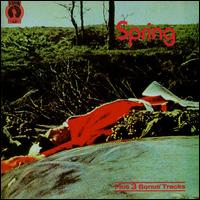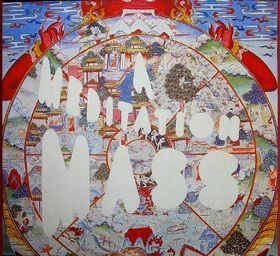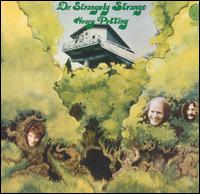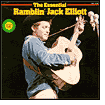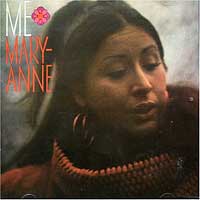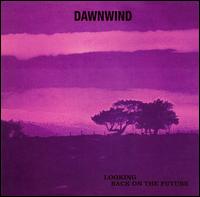
Ask the average folk enthusiast who Derroll Adams is, and chances are you'll get a vague glimmer of recognition, followed by a shrug of puzzlement. Few figures have effected as much of an impact on other musicians, while falling by the wayside before the public. Indeed, the only comparable figure who comes immediately to mind is England's
Davy Graham, who influenced an entire generation of folk and rock guitarists, and at least one superstar (
Paul Simon), but hasn't courted serious record sales in decades. Born Derroll Lewis Thompson in Portland, Oregon, he was the son of a vaudeville juggler and master storyteller. At age 16, just about the time that the Second World War was breaking out, Adams joined the Army, but was discharged within a few months when his age was discovered. He later served in the United States Coast Guard, after which he attended art school — it was during this time that Adams chanced to see a concert by
Josh White, which set him on the road to becoming a musician. His subsequent hearing of records by
Pete Seeger,
Woody Guthrie, and
Cisco Houston only reinforced his love of folk music, and in a surprisingly short time, he'd become proficient on the guitar and a near-virtuoso on the banjo. He played for audiences as part of former Vice President Henry Wallace's 1948 presidential campaign. During the 1950s, Adams hooked up with the folk singer
Odetta in an organization known as "World Folk Artists," and began building an audience; by the end of the decade, his banjo playing was being used on some film soundtracks. In 1957, Adams had his first successful song, "Portland Town," an account of birth, life, and death that became his magnum opus, covered widely over the years by other folk singers. Around the same time, he met up with
Ramblin' Jack Elliott, who, with his wife, invited Adams to come to England with them. Over the next few years, the three played numerous folk clubs in England, while Adams resided for a time with songwriter
Lionel Bart and also performed on the European continent. Adams and
Elliott also made recordings together for Topic Records, which was then England's leading folk label. In 1966, while traveling through Europe, they cut an album together in Milan, Italy. By this time, Adams was a fixture on the European folk scene, his rough-hewn voice and distinctive banjo style drawing a serious following, especially among the new generation of folk performers coming up behind him. All wasn't well, however, as Adams became increasingly disenchanted with the widening audience for folk music. Where the clubs in the early '60s had been attended by serious listeners with an honest interest, by 1966 he found himself playing more often to rowdy, drunken listeners who cared little for what he was actually doing. He became known for incidents in which he would smash his guitar and leave the stage. Finally, he met a woman from Belgium who became his fourth wife, and he left the music business to help run her decorating business. His influence lingered, however. In 1967, even as Adams was temporarily retired, he became the subject of perhaps the best song that
Donovan Leitch (aka
Donovan) has ever written, "Epistle to Derroll." Appearing on the
Gift From a Flower to a Garden album, the words and music reflected the debt that
Leitch owed Adams as a musician and songwriter — the entire song, and specifically the line "bring me word of the banjo man with the tattoo on his hand," may be the most poignant and haunting in
Donovan's entire song output. Both his wife's business and the accompanying marriage failed, however, and Adams resumed his performing career in Europe's folk clubs, his name still widely known on his adopted continent. He proved a fairly controversial figure, however, for his rejection of authenticity and his purist approach to folk music; he insisted that old songs could be performed perfectly well in new ways, and he occasionally got drunk and swore on-stage . Still, he continued playing, and in 1991, the folk community — including the members of
Pentangle, as well as his former partner
Elliott and veterans like
Happy Traum — turned out for a concert celebrating Adams' 65th birthday, which was later released on record. Derroll Adams passed away on February 6, 2000 in Antwerp, Belgium. He remains unjustifiably better known in Europe than in the country of his birth. (from
www.allmusic.com)
I did not know this musician (as a singer) , although I did know he was playing with Ramblin Jack Elliot.
A friend of mine told me about him and suddenly something changed inside me when I listened to him. Maybe he is one of the best folkers around. I do not like banjo very much,
I don’t like the sound of banjo. But with this man, I adore banjo, his voice, the guitar, everything. He is a real troubadour, no doubts. “Feelin Fine” was first posted by janisfarm in
http://lost-in-tyme.blogspot.com/, you should get this also!
Many thanks to janisfarm for letting me know Derroll. After I listened to him, I finally found this compilation, Songs of the banjoman. It is a great record!!
Now I am also looking for his first record, Portland Town-1967.
Amazing lyrics, hippie emotional lyrics..check it out:
Derroll Adams - The Valley Autumn time is getting closer Soon green leaves will start to fade
Dripping rain they'll start a-falling
Summer's gone and past away
Children's hopes are like green leaves
They soon fade and tumble down
Come to rest in that lonesome valley
Where they never can again be found
That lonesome valley's name is sadness
Flowers they are coloured blue
Autumn leaves are coloured sorrow
There's not many left to fall
Children's hopes are like green leaves
They soon fade and tumble down
Come to rest in that lonesome valley
Where they never can again be found...
Winds played rain will be the music
Played upon those falling leaves
Played deep within that frost white valley
Summer's gone and past away
Children's hopes are like green leaves
They soon fade and tumble down
Come to rest in that lonesome valley
Where they never can again be found...Derroll Adams - LovesongMy heart is like a flower for my love
That blooms as I hold her tenderly
But it's planted deep in fear
Just as heavy as the tear
That whispers low her love is not for me
My love is true
For her it is true
And I pray that her love is mine
My love is like the first star of the night
That brightens up the world's first darkness
Like love stories very old
That a million times been told
Her eyes are worth more than bright diamonds
My love is true
For her it is true
And I pray that her love is mine
Alone at night in my dark lonesome room
I lay awake and sadly dreaming
Though she's not very near But still I can hear
Her soft and tender heart a-beating
My love is true
For her it is true
And I pray that her love is mine
Highly Recommended!!!!!!!!!!!!!! Amazing true voice!!Listen!!!
 This Norwegian folk outfit started out in the early 70s mixing acoustic instruments (fiddle, mandolin, banjo and piano) with the electric guitar, bass and keyboards. They created an earthy music made up of playful, catchy melodies with male/female vocal interplay. Despite important personnel changes over the years (their first-rate lead female singer was replaced, among others), they have managed to remain true to their sound and have churned out over ten fine albums between 1974 and 1998. In 2004, they reunited to play a gig at the Norsk Folkemuseum and don’t seem to show any signs of slowing down.Their highest rated album is their third, entitled “Vardøger”, closely followed by their first two, “Folque” and “Kjempene På Dovrefjell” released in the mid-70s, and by “Fredløs” and “Sort Messe” released in the early 80s. Their material is pure, often foot-stomping folk with Norwegian vocals. Despite the mostly minor keys, it is fresh and exhilirating and dons some wonderful arrangements.Highly recommended to fans of MALICORNE, The POGUES, KEBNEKAISE and GRYPHON as well as those heavily into Nordic and Irish folk. A good introduction is the recent live sampler “Stormkast”,
This Norwegian folk outfit started out in the early 70s mixing acoustic instruments (fiddle, mandolin, banjo and piano) with the electric guitar, bass and keyboards. They created an earthy music made up of playful, catchy melodies with male/female vocal interplay. Despite important personnel changes over the years (their first-rate lead female singer was replaced, among others), they have managed to remain true to their sound and have churned out over ten fine albums between 1974 and 1998. In 2004, they reunited to play a gig at the Norsk Folkemuseum and don’t seem to show any signs of slowing down.Their highest rated album is their third, entitled “Vardøger”, closely followed by their first two, “Folque” and “Kjempene På Dovrefjell” released in the mid-70s, and by “Fredløs” and “Sort Messe” released in the early 80s. Their material is pure, often foot-stomping folk with Norwegian vocals. Despite the mostly minor keys, it is fresh and exhilirating and dons some wonderful arrangements.Highly recommended to fans of MALICORNE, The POGUES, KEBNEKAISE and GRYPHON as well as those heavily into Nordic and Irish folk. A good introduction is the recent live sampler “Stormkast”,

 Many die-hard folkys consider Dave Van Ronk in a class apart from his contemporaries — such as
Many die-hard folkys consider Dave Van Ronk in a class apart from his contemporaries — such as 
